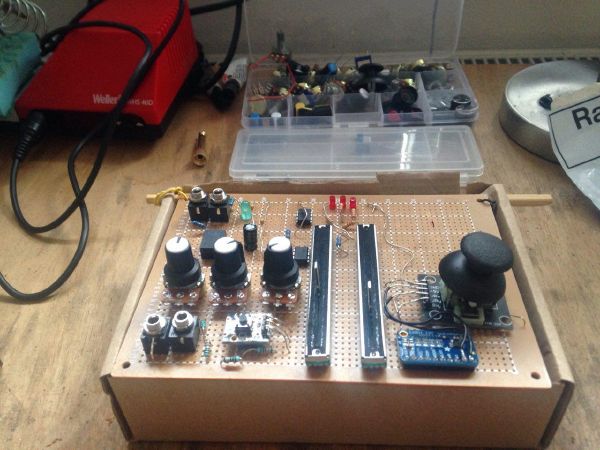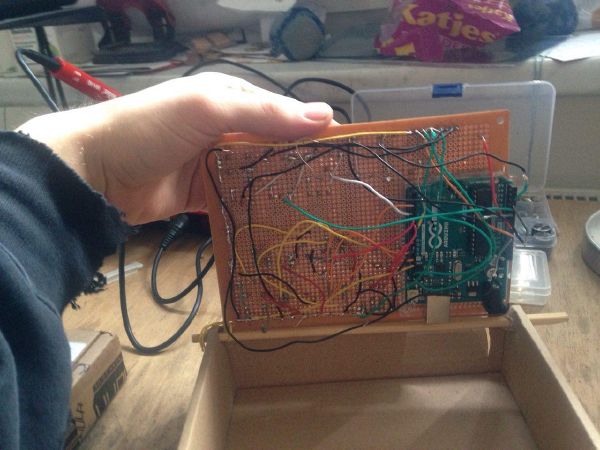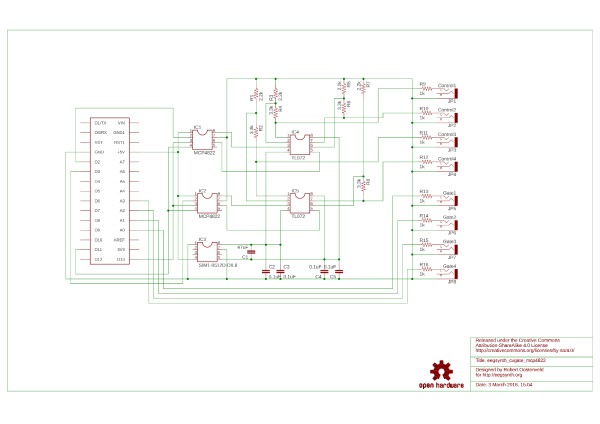No edit summary |
No edit summary |
||
| Line 31: | Line 31: | ||
|- | |- | ||
|} | |} | ||
It converts digital data from the arduino (connected through SDI) over an external 12Bit DAC to 0-4V and scales the range over an OpAmp to 0-10V. This device is able to do this on 4 channels, for us 2 was enough, so we cutted away the half of the original circuit. Also we skipped the 4 Gate Outputs. So what we were having then was basically one 12Bit DAC (MCP4822), one OpAmp (TL072) and one DC-DC Converter (SIM 0512D) and the needed resitors and capacitors which can be seen in the original schematic. | |||
Revision as of 09:56, 26 February 2020
Werkmodul
Analog Circuits and Interfaces
Instructor: Clemens Wegener
Credits: 6 ECTS, 3 SWS
Project by Paul and Joel Schaefer


The inspiration for making this device was the old "A-174-1 Joy Stick" Module by Doepfer and the famous Eurorack Interface ES-X series by Expert Sleepers. The reason for our interest in a Joystick as Control element for analog devices is simply the functional advantage its having, meaning the possibilty to tweak 2 Values with 1 Movement. The interest in dc coupled Interfaces like the Expert Sleepers series is obvious. The idea of generating and receiving control voltage in a digital environment on the pc with software like "CV Tools" by Ableton seems to be pretty interesting. Not just for the sake of an easier and accurate way to generate Control Voltage, no also in the sense of communication between devices and softwares. For example, to make generative Computergraphics with Software like Unity, TouchDesigner or Blender and use control voltage from your Modular Synth to control aspects of the generative Video Output. Or the other way around to generate Video Output inside such software through different functions and to use this data also for the generation of sound through Analog Synthesizers. Not to mention feedback loops. So, we think a dc coupled interface that bridges the world of analog and digital without the use of the extremely quality dropping MIDI protocol is a thing that holds a very big potential for many artistically interesting uses. Anyway, as dc coupled interfaces appear to be not very common and quite expensive on the market of audio interfaces we wanted to create a similiar device ourself thats able to send and receive analog Signals over USB connection.
So we we decided to use an Arduino Uno for our project. The starting point was this great, creative common released, open hardware device we found on github.
https://github.com/eegsynth/eegsynth/tree/master/hardware/usb2cvgate_4channel
Its designed by Robert Oostenveld for eegsynth.org. This is the original Schematic:

It converts digital data from the arduino (connected through SDI) over an external 12Bit DAC to 0-4V and scales the range over an OpAmp to 0-10V. This device is able to do this on 4 channels, for us 2 was enough, so we cutted away the half of the original circuit. Also we skipped the 4 Gate Outputs. So what we were having then was basically one 12Bit DAC (MCP4822), one OpAmp (TL072) and one DC-DC Converter (SIM 0512D) and the needed resitors and capacitors which can be seen in the original schematic.